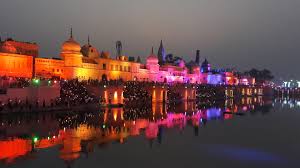Ayodhya: A Pilgrimage Site of Great Importance

Introduction
Ayodhya, a city located in the Indian state of Uttar Pradesh, holds immense cultural and religious significance for millions of Hindus worldwide. According to Hindu belief, Ayodhya is the birthplace of Lord Rama, a key figure in the epic Ramayana. The city’s ancient temples and historical sites attract thousands of pilgrims and tourists, emphasizing the importance of Ayodhya not just as a religious center but as a symbol of India’s rich heritage.
Current Developments
In recent years, Ayodhya has been in the spotlight, particularly following the landmark Supreme Court verdict in November 2019, which paved the way for the construction of a grand Ram Temple at the disputed site. This ruling concluded a long-standing dispute regarding ownership of the site, which has been a focal point of communal tensions in the country for decades. Following the court’s decision, the foundation stone for the Ram Temple was laid by Prime Minister Narendra Modi in August 2020, marking a significant milestone in Ayodhya’s modern history.
The construction of the temple is expected not only to enhance the religious stature of Ayodhya but also to boost the local economy through increased tourism. With ongoing infrastructure projects, including better roads and accommodations, Ayodhya aims to cater to millions of visitors who are anticipated to flock to the city once the temple is completed.
Economic and Cultural Impacts
The development of Ayodhya into a prominent pilgrimage destination has led to a surge in local businesses, including hospitality, food, and transportation services. Reports suggest that the local government has invested in enhancing the city’s overall infrastructure to handle increased footfall. Furthermore, this development is expected to create job opportunities for residents, aiding in the economic upliftment of the region.
Culturally, Ayodhya is poised to become a hub for Hindu festivals, rituals, and events. Important celebrations, such as Diwali and Ram Navami, are likely to attract not only local devotees but also visitors from around the globe, reaffirming Ayodhya’s significance as a center of cultural convergence.
Conclusion
The ongoing developments in Ayodhya signify its transformation into a significant cultural and religious center in India. As the Ram Temple nears completion, it is crucial for both the local community and the Indian nation to embrace the spirit of unity and communal harmony. The significance of Ayodhya goes beyond its historical and religious narratives, symbolizing India’s diversity and the rich tapestry of its cultural heritage. With the promise of growth and change, Ayodhya stands on the cusp of a new era, inviting followers and seekers of peace, spirituality, and unity.









